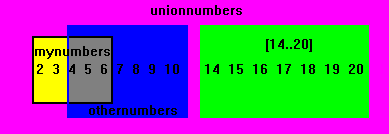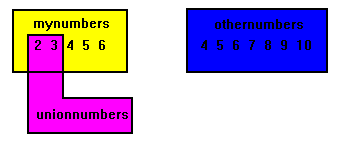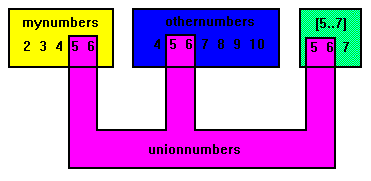



SETS
Sets exist in every day life. They are a way of classifying common
types into groups. In Pascal, we think of sets as containing a range
of limited values, from an initial value through to an ending value.
Consider the following set of integer values,
1, 2, 3, 4, 5, 6, 7, 8, 9, 10This is a set of numbers (integers) whose set value ranges from 1 to 10. To define this as a set type in Pascal, we would use the following syntax.
program SetsOne( output ); type numberset = set of 1..10; var mynumbers : numberset; begin end.The statement
type numberset = set of 1..10;declares a new type called numberset, which represents a set of integer values ranging from 1 as the lowest value, to 10 as the highest value. The value 1..10 means the numbers 1 to 10 inclusive. We call this the base set, that is, the set of values from which the set is taken.
The base set is a range of limited values. For example, we can have a set of char, but not a set of integers, because the set of integers has too many possible values, whereas the set of characters is very limited in possible values.
The statement
var mynumbers : numberset;makes a working variable in our program called mynumbers, which is a set and can hold any value from the range defined in numberset.
Consider the following statement which assigns values to a set
program SetsTWO( output ); type numberset = set of 1..10; var mynumbers : numberset; begin mynumbers := []; mynumbers := [2..6] end.The statement
mynumbers := [];assigns an empty set to mynumbers. The statement
mynumbers := [2..6];assigns a subset of values (integer 2 to 6 inclusive) from the range given for the set type numberset. Please note that assigning values outside the range of the set type from which mynumbers is derived will generate an error, thus the statement
mynumbers := [6..32];is illegal, because mynumbers is derived from the base type numberset, which is a set of integer values ranging from 1 to 10. Any values outside this range are considered illegal.
Determining if a value is in a set
Lets expand the above program example to demonstrate how we check to
see if a value resides in a set. Consider the following program, which
reads an integer from the keyboard and checks to see if its in the set.
program SetsTHREE( input, output );
type numberset = set of 1..10;
var mynumbers : numberset;
value : integer;
begin
mynumbers := [2..6];
value := 1;
while( value <> 0 ) do
begin
writeln('Please enter an integer value, (0 to exit)');
readln( value );
if value <> 0 then
begin
if value IN mynumbers then
writeln('Its in the set')
else
writeln('Its not in the set')
end
end
end.
More on set UNION, combining sets
Lets now look at combining some sets together. Consider the following
program, which creates two sets, then joins the sets together to create
another.
program SetsUNION( input, output );
type numberset = set of 1..40;
var mynumbers, othernumbers, unionnumbers : numberset;
value : integer;
begin
mynumbers := [2..6];
othernumbers := [4..10];
unionnumbers := mynumbers + othernumbers + [14..20];
value := 1;
while( value <> 0 ) do
begin
writeln('Please enter an integer value, (0 to exit)');
readln( value );
if value <> 0 then
begin
if value IN unionnumbers then
writeln('Its in the set')
else
writeln('Its not in the set')
end
end
end.
The statement
var mynumbers, othernumbers, unionnumbers : numberset;declares three sets of type numberset.
The statement
mynumbers := [2..6];assigns a subset of values (integer 2 to 6 inclusive) from the range given for the set type numberset.
The statement
othernumbers := [4..10];assigns a subset of values (integer 4 to 10 inclusive) from the range given for the set type numberset.
The statement
unionnumbers := mynumbers + othernumbers + [14..20];assigns the set of values in mynumbers, othernumbers and the set of values of 14 to 20 to unionnumbers.
If a specific value occurs in more than one set (as is the case of 4, 5, and 6, which are in mynumbers and othernumbers), then the other duplicate value is ignored (ie, only one instance of the value is copied to the new set.
This means that unionnumbers contains the values

program SetsDIFFERENCE( input, output );
type numberset = set of 1..40;
var mynumbers, othernumbers, unionnumbers : numberset;
value : integer;
begin
mynumbers := [2..6];
othernumbers := [4..10];
unionnumbers := mynumbers - othernumbers;
value := 1;
while( value <> 0 ) do
begin
writeln('Please enter an integer value, (0 to exit)');
readln( value );
if value <> 0 then
begin
if value IN unionnumbers then
writeln('Its in the set')
else
writeln('Its not in the set')
end
end
end.
unionnumbers contains the values

program SetsINTERSECTION( input, output );
type numberset = set of 1..40;
var mynumbers, othernumbers, unionnumbers : numberset;
value : integer;
begin
mynumbers := [2..6];
othernumbers := [4..10];
unionnumbers := mynumbers * othernumbers * [5..7];
value := 1;
while( value <> 0 ) do
begin
writeln('Please enter an integer value, (0 to exit)');
readln( value );
if value <> 0 then
begin
if value IN unionnumbers then
writeln('Its in the set')
else
writeln('Its not in the set')
end
end
end.
unionnumbers contains the values



